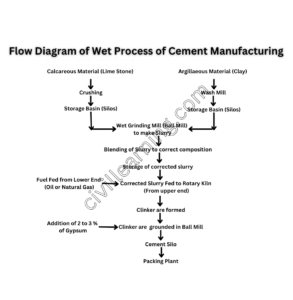Cement Manufacturing Process
Joseph Aspadin (Great Scientist) first started manufacturing cement in England. First manufacturing name of cement is ordinary Portland cement (OPC) because when cement mixes with water it converts to a solid mass after some period and this solid mass (looks like solid stone) is rooted in the Portland (England).
India is the 2nd largest cement manufacturing country after china.
Cement is produced by mixing calcareous material like lime and argillaceous material in a ratio of 3 part:1 part. Examples of calcareous material are limestone, seashells, chalk and marl and on the other side, examples of argillaceous material are clay, slate, shale and blast furnace slag etc.
Types of Cement Manufacturing Process
Cement manufacturing process can be divided into two types.
- Dry Process
- Wet Process
Dry Process
Dry and hard materials are used in the dry process of cement manufacturing. Crushing, mixing of raw materials are done perfectly before the burning process.
The various stages of the dry process of cement manufacturing are described below.
Crushing Stage
- The calcareous material and argillaceous material are ground individually to a size of 25 mm in the crusher and then pulverised individually into fine powder in tube mills and ball mills.
- After crushing stage completion, crushed materials are stored in hoppers.
Mixing Stage
- The crushed materials are then mixed in proportion in dry form with the help of compressed air. This mix is called raw mix.
- Finally, this raw mix is stored in a storage tank.
Burning Stage
- Raw mix is then entered into the upper end of the steel rotary kiln. Hot flames and gases are entered through the lower end of the rotary kiln.
- As the raw mix goes down the rotary kiln, temperature continuously increases. The absorption of moisture and CO2 increases the setting of cement.
- Finally, at the lower end of the rotary kiln, temperature is about 1500°C to 1700°C. Calcination process takes place in the lower end (burning zone) of the rotary kiln and clinkers are formed.
Cooling Stage
- Size of clinkers are 5mm to 10mm and are very hot when they are formed. Another rotary kiln is laid to cool the clinker and then cooled clinkers are stored.
Grinding Stage
- After cooling the clinkers, clinkers are ground in tube mills and ball mills.
- To avoid flash sets, 3 to 5% of gypsum is used during the grinding stage.
- After the grinding stage, cement is stored into big silos.
Packing Stage
- Then, the cement is weighed and packed in 50 kg bags with the help of an automatic machine. The volume of 1 bag cement is 0.035 m3.
Advantages of Dry Process of Cement Manufacturing
- Labour efficiency increased in the dry process of cement manufacturing.
- Less capital is required to start cement manufacturing.
- Low fuel consumption due to dry mix of raw material.
Disadvantages of Dry Process of Cement Manufacturing
- Dry process of cement manufacturing is very slow.
- Overall cost of the dry process of cement manufacturing is high.

Wet Process
In the wet process, slurry has used 30% to 50% of water. This slurry increases the consumption of fuel.
The various stages of the wet process of cement manufacturing are described below.
Crushing Stage
- Calcareous materials are crushed and stored in storage tanks. Argillaceous materials are mixed with water and stored in a basin.
- Calcareous materials and slurry of clay mixed in channels in specific proportions. Then mixed slurry is entered into the special basin where the stirring process is done.
- Finally, slurry is stored in a storage tank and then entered into a rotary kiln.
Burning, Cooling, Grinding and Packing is done in the same way as the dry process of cement manufacturing.
Advantages of Wet Process of Cement Manufacturing
- The cost of crushing the material is low due to the wet process.
- Accuracy of mixing of slurry is achieved.
Disadvantages of Wet Process of Cement Manufacturing
- Consumption of fuel is too high because of the wet process.

Difference between Dry and Wet Process of Cement Manufacturing
| Sr. No | Dry Process | Wet Process |
| 1 | Mixing process is done in dry form. | Mixing process is done in wet form. (water is added) |
| 2 | After mixing of material, Raw mix is produced. | After mixing of material, slurry is produced. |
| 3 | Fuel consumption is low. | Fuel consumption is high. |
| 4 | Material should be dry before mixing. | Material drying is not mandatory before wet mixing. |
| 5 | In raw mixing, material should be hard. | Any type of material can be used in mixing. |
| 6 | Cost of production is high as compared to wet processes. | Cost of production is low as compared to the dry process. |
| 7 | Quality of cement is low as compared to wet process production | Quality of cement is good. |
|
Similarity |
||
| 8 | In both processes,for burning process, slurry is fed into steel rotary kiln. | |
| 9 | Burning, Cooling, Grinding and Packing stages are the same in both processes. | |
Packaging of Cement
Packing of cement is done in 50 kg quantity. The volume of 1 bag cement is 0.035 m3. Materials of packaging of cement are high density polyethylene and polyethene lines jute bags.
FAQs
What are two basic materials used for the manufacture of cement?
Two basic materials used for manufacture of cement are calcareous material like lime and argillaceous material.
Why is gypsum added in the manufacture of Portland cement?
To avoid flash sets, 3 to 5% of gypsum is used during the grinding stage.